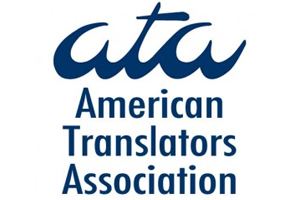Abbreviation ATA Legal status Association Founded 1959 | Formation 1959 President of the Board of Directors Caitlin Walsh | |
 | ||
Membership translators, interpreters, institutions, translation companies Similar Translators Without Borders, Middlebury Institute of Internatio, National Language Service C, National Center for State Cou, Association of Translato Profiles | ||
American translators association conference times square nyc video productions
The American Translators Association (ATA) was founded in 1959 and is now the largest professional association of translators and interpreters in the United States with more than 10,000 members in 90 countries.
Contents
- American translators association conference times square nyc video productions
- Kurdish genocide introduction video american translators association 2014
- Professional development
- Certification
- Governance
- Current officers
- Publications
- Structure
- ATA chapters
- Affiliated groups
- Honors awards and scholarships
- References
Membership is open to anyone with an interest in translation and interpreting as a profession or as a scholarly pursuit. Members include translators, interpreters, teachers, project managers, web and software developers, language services companies, hospitals, universities, and government agencies.
ATA offers certification examinations for its members in some language combinations and is affiliated with the International Federation of Translators (FIT). The association is headquartered in Alexandria, Virginia.
Unlike a trade union, the ATA represents both "labor" and "management"—that is, both the translators who produce written translations and the translation agencies who purchase them. The ATA likewise does not provide benefits, such as collective bargaining or health insurance, to its freelance members.
Kurdish genocide introduction video american translators association 2014
Professional development
ATA's primary goals are to foster and support the professional development of translators and interpreters and to promote the translation and interpreting professions. The Association offers a variety of programs and services in support of these goals, including a series of one-day seminars and workshops throughout the year and an ATA Annual Conference every fall—both of which feature education and training concerning diverse specialties and languages.
Certification
The ATA currently offers certification exams in the following language pairs:
Into English from Arabic, Croatian, Danish, Dutch, French, German, Hungarian, Italian, Japanese, Polish, Portuguese, Russian, and Spanish.
From English into Chinese, Croatian, Dutch, Finnish, French, German, Hungarian, Italian, Japanese, Macedonian, Polish, Portuguese, Russian, Spanish, and Ukrainian
As of 2004, the organization requires members to complete a certain number of "continuing education" points from among offerings approved by the association in order to retain certification after passing a certification examination.
Governance
ATA is governed by its Bylaws, and has a President, a President-Elect, a Secretary, a Treasurer, and a Board of Directors, which has nine members. In addition, there is an Executive Director in charge of operations.
Current officers
Publications
The Chronicle is a monthly publication available only in hard-copy format that combines articles on various translation-related issues with regular features.
Structure
ATA divisions provide members with common interests a way to network and receive career updates. The divisions offer newsletters, online forums, seminars, conference presentations, and networking sessions. ATA offers 16 special interest groups or divisions [1], based on language or subject-area specialty. Any member of the ATA can belong to any division(s).
ATA chapters
ATA chapters and affiliates provide regional information, marketing, networking, and support services to local translators and interpreters.
Affiliated groups
Honors, awards and scholarships
The American Translators Association presents a number of awards and scholarships to members of the translation and interpreting professions. These include:
